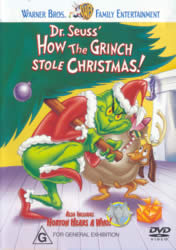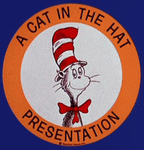How the Grinch Stole Christmas/Horton Hears a Who! (Dr. Seuss') (1966) |
|
How the Grinch Stole Christmas/Horton Hears a Who! (Dr. Seuss') (1966) |
|


|
| BUY IT |
| General | Extras | ||
| Category | Childrens |
Main Menu Audio Gallery-Pencil Tests (Grinch/Horton) Music Highlights-(Grinch/Horton) Audio Commentary Featurette-TNT's How The Grinch Stole Christmas Special Edition (19:20) Featurette Featurette-Dr. Seuss' Horton Hears A Who! |
|
| Rating |

|
||
| Year Of Production | 1966 | ||
| Running Time | 49:03 | ||
| RSDL / Flipper | No/No | Cast & Crew | |
| Start Up | Menu | ||
| Region Coding | 2,4 | Directed By | Chuck Jones |
|
Studio
Distributor |
 Warner Home Video |
Starring | None Given |
| Case | Amaray-Transparent | ||
| RPI | $29.95 | Music | Albert Hague |
| Video | Audio | ||
| Pan & Scan/Full Frame | Full Screen, not known whether Pan & Scan or Full Frame |
English Dolby Digital 2.0 French Dolby Digital 2.0 (192Kb/s) German Dolby Digital 2.0 Icelandic Dolby Digital 2.0 Spanish Dolby Digital 2.0 English Audio Commentary Dolby Digital 2.0 |
|
| Widescreen Aspect Ratio | None | ||
| 16x9 Enhancement | No | ||
| Video Format | 576i (PAL) | ||
| Original Aspect Ratio | Unknown | Miscellaneous | |
| Jacket Pictures | No | ||
| Subtitles |
English Dutch Polish |
Smoking | No |
| Annoying Product Placement | No | ||
| Action In or After Credits | No | ||
When you put together the animation talents of Chuck (Bugs Bunny) Jones, the storywriting abilities of Theodore (Dr. Seuss) Geisel and the musical ability of Albert Hague, you know you're on a winner.
Nearly everyone can think back to their childhood and remember at least one Dr. Seuss book. The ones in my personal collection (which I grudgingly had to share with my sister) were Green Eggs and Ham, Cat In The Hat and Hand, Hand Fingers, Thumb. I think it was Seuss' ability to relate to kids that made his books such a popular read. There was also pleasure to be had by being able to put your tongue around those massive twisting and rhyming words before your parents could. Remember do you; Pantookas, Whoflut flants (which came in yard lengths), floo floobbers and riding on tah-tinkers to name just a few.
The first project that Jones and Geisel worked on was for the US military, a cartoon character called Private Snafu. It wasn't until 25 years later in 1966 that the story "How the Grinch Stole Christmas" made the transition from book to silver screen. At first, Geisel was so protective of his work that he didn't want to make the jump to animation and preferred to maintain only the printed form.
Once his decision was made though, Geisel needed to put together a team that would see the project through to the end. His first port of call was selecting the voice actors to bring the animations to life. He chose Boris Karloff as the voice for the story's narration. But, as Boris could not sing, an additional voice was required for the musical sections. Seuss chose Thurl Ravenscroft (who missed out on naming credits by the way) for the part. Thurl's best-known voice is "Tony" the tiger in Kellogg's Frosty Flakes advertisements. The female voice for Cindy Lou Who was performed by June Foray. Her vocal qualities were better known for Bullwinkle's sidekick Rocky.
Albert Hague composed all 3 songs featured in this classic, the polka-styled "Trim Up The Tree", "Welcome Christmas" and "You're a Foul One, Mr Grinch". However, Albert will most likely be remembered as Professor Shorofsky, the music teacher in the movie and TV series "FAME".
These talented voices and great compositions were then pieced together with cel animations to make the classic as it stands today. To give you a small idea of what was involved; as 24 separate frames are required for each second of film, an animation needs 1 new drawing or animated cell every 2 frames. That is 12 pieces of artwork for each second of film, making this Grinch feature a whopping collection of 17,000 highly specific hand-drawn animation cels.
The original book version could be read in around 12 minutes. The animated version stretches this story to 24:32 with the additional time being in the centre of the feature. Geisel and Jones felt that by extending this section they would be able to play on the comedic qualities that this scene presented in animated form. It occurs where Max the tiny dog is tied up (at 10:00) to a heavy sleigh and had numerous problems trying to manoeuvre it down the snow-filled slopes.
This was a fine production for its day and something that has yet to become dated. I honestly think it never will . . .
The picture is rather soft with no crisp edges or sharp delineation between lines. Luminance levels are acceptable but certainly showing their age. The best example of this is at 10:10 on a close-up of the Grinch's face where you get to see the softer appearance and the general softness of the lines in his face. Some sections appear intentionally soft, as if Jones has used a moist finger to smudge some of the lines to reduce their harsh appearance.
The colours were also soft but there was a varied palette and never-ending use of colour when required.
The entire presentation suffers from a level of grain that runs from acceptable to so much so that it almost looks like a mild stain across the cels. Whilst it was a little annoying at times, it should not be a bother to the target audience. Film artefacts are constant but quite often small with no specific areas that had me sitting up and taking specific notice. Bear in mind that this is film stock dating back to 1966 which has had only one minor touch-up in 1970. Conversely, Horton Hears A Who offers up more vibrant colours and considerably less grain and is just a better quality presentation overall. This is no doubt due in part to it being considerably younger than the main Grinch production featured here.
The subtitles are close to, but not exact to the spoken word.
This disc is a single sided and single layered disc, and therefore there is no layer change.
| Sharpness | |
| Shadow Detail | |
| Colour | |
| Grain/Pixelization | |
| Film-To-Video Artefacts | |
| Film Artefacts | |
| Overall |
There is only one audio option on this disc; an English Dolby Digital 2.0 surround-encoded soundtrack.
The dialogue was clear and easy to understand at all times with no apparent hiss. Audio sync was as accurate as you can get for an animated feature.
The music was artistic and gave an audible bounce to all the tunes. It was definitely well-suited to the visual content. The volume levels did not drown out the dialogue at any point during the movie.
The surround channels were lightly used primarily during the music scenes. They provided a nice level of ambience when required.
The subwoofer was inactive for the entire length of the feature (not that it was really required at any point).
| Dialogue | |
| Audio Sync | |
| Clicks/Pops/Dropouts | |
| Surround Channel Use | |
| Subwoofer | |
| Overall |
You can quickly select the 4 songs that are in this feature. Handy if the kids just want to do some singing. The songs are;
NOTE: To view non-R4 releases, your equipment needs to be multi-zone compatible and usually also NTSC compatible.
The Region 4 version of this disc misses out on;
Overall, this is a fun animation especially for anyone that hates Christmas. Kids will love it and thanks to the marvels of DVD they will be able to play it more times than the VHS would ever allow.
The video quality is definitely showing its age and considering its never-ending popularity we may see the production undergo another touch-up in the future.
The audio quality is considerably better than the video.
The extras are very satisfactory, especially the Horton Hears A Who separate feature. Well worth putting in the kids' collection, especially if they are fans of the Dr. Seuss books.
| Video | |
| Audio | |
| Extras | |
| Plot | |
| Overall |
| Review Equipment | |
| DVD | Pioneer DV-533K, using S-Video output |
| Display | Loewe 72cm. Calibrated with Video Essentials. This display device is 16x9 capable. |
| Audio Decoder | Built in to amplifier/receiver. Calibrated with Video Essentials. |
| Amplification | Denon AVR-2802 Dolby EX/DTS ES Discrete |
| Speakers | Whatmough Audiolabs Magnum M30 (Mains); M05 (Centre); M10 (Rears); Magnat Vector Needle Sub25A Active SubWoofer |